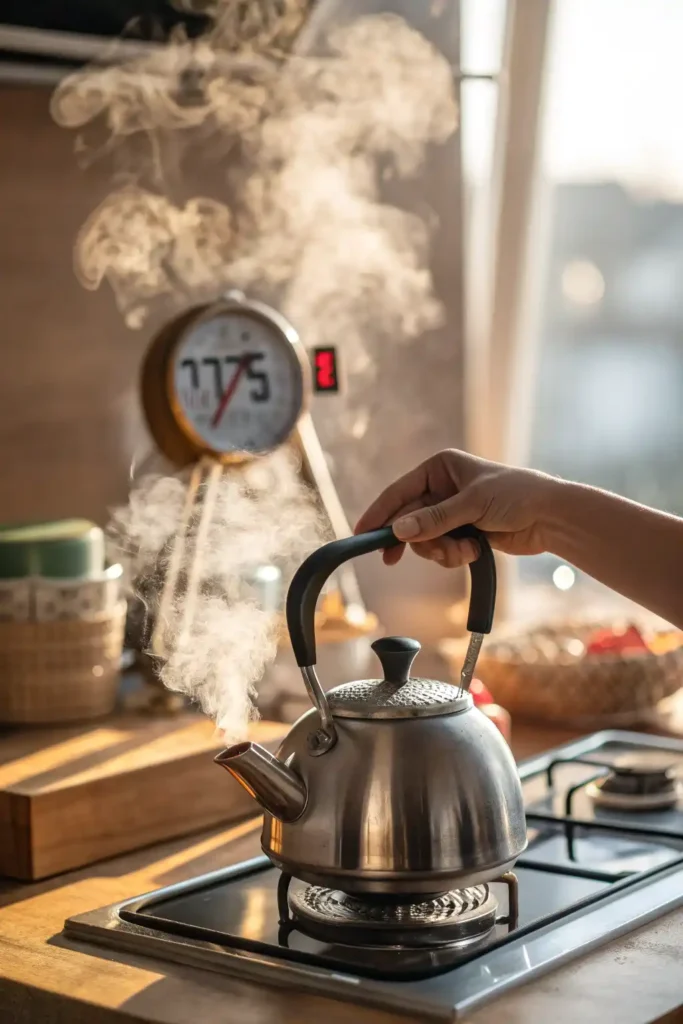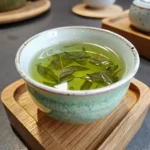How to steep tea without bitterness green tea that’s the secret Mia had been chasing since her twenties. At 45 now, every sip still brings her back to that tiny tea stall tucked inside a Beijing alley, where she first fell in love with the comforting warmth of fresh green tea smooth, floral, and utterly soothing. But when she got back home to California, something always felt…off. Her green tea tasted harsh, grassy, bitter.
It didn’t matter if it was a high-end organic brand or a budget-friendly box from the supermarket the bitterness lingered. Friends told her it was just how green tea tasted. But Mia knew better. There had to be a way to brew it right.
For years, she experimented every weekend. She tried adjusting the water temperature, switched between loose leaves and sachets, even steeped her tea upside down (don’t ask). But none of it truly worked until she discovered the secret formula behind how to steep tea without bitterness in green tea. The real trick wasn’t complicated, just misunderstood. It came down to science, subtlety, and patience.
Today, Mia brews green tea so perfectly mellow and sweet, it surprises even her most skeptical guests. They often ask, “Why doesn’t this taste like the bitter stuff I get in restaurants?” She smiles, and gently tells them, “It’s not the tea it’s how you treat it.”
This article is your step-by-step guide to how to steep tea without bitterness green tea, just like Mia learned over time. We’ll dive into the why, the how, and all the small things that make a big difference starting with understanding what’s really behind that bitterness. Along the way, you’ll learn everything from water quality and steeping time to how Chinese tea masters make it so effortlessly good..
Understanding Why Green Tea Turns Bitter
PrintRefreshing Iced Green Tea Without Bitterness
- Prep Time: 2
- Total Time: 2 minutes
- Yield: 1 1x
- Category: Beverage
- Cuisine: Asian/Wellness
Ingredients
-
1 tsp loose Sencha or Gyokuro
-
8 oz filtered water (170–180°F)
-
Optional: lemon slice, mint, or honey
Instructions
-
Heat water to 175°F
-
Steep tea for 2 minutes, covered
-
Cool to room temp
-
Pour over ice
-
Garnish with lemon or mint
The Science Behind Bitterness in Green Tea
When learning how to steep tea without bitterness green tea, it’s essential to understand the chemical nature of this ancient beverage. Green tea is rich in polyphenols, particularly catechins, which offer powerful antioxidant benefits. While catechins help reduce inflammation, support metabolism, and fight free radicals, they are also highly reactive to heat and time. That’s where the trouble begins.
As soon as you pour boiling water over green tea leaves, these beneficial compounds begin to break down rapidly. What results is a surge of bitterness that overpowers the tea’s natural vegetal and floral notes. If you’ve ever tasted a cup that felt sharp or unpleasantly harsh on the tongue, it’s likely because the tea was steeped either too hot or too long.
Another culprit? Green tea undergoes minimal processing, unlike black tea, making it more susceptible to over-oxidation. The leaves are quickly steamed or pan-fired after harvesting to halt oxidation, which preserves their fresh, grassy flavor. As a result, they’re more delicate and need precise brewing to prevent a bitter taste.
Role of Catechins and Tannins in Bitterness
Tannins are another type of polyphenol that contribute to the bitter, astringent quality of green tea. Found in the cell walls of tea leaves, tannins are released during steeping and add structure and depth to the brew. But too many tannins result in a drying sensation and a puckering mouthfeel.
When figuring out how to steep tea without bitterness green tea, balance is everything. Catechins deliver health benefits but can become unpleasant under the wrong conditions. Tannins provide complexity but can overwhelm the palate. The goal is to extract just enough of these compounds to enjoy the flavor and the benefits without the bitterness.
Choosing the Right Green Tea for Smooth Flavor for How to steep tea without bitterness green tea

Best Green Tea Varieties to Avoid Bitterness
Choosing the right green tea is just as crucial as how you brew it. If your goal is how to steep tea without bitterness green tea, start with varieties known for their mellow taste.
- Sencha (Japan): The most popular Japanese green tea, Sencha is steamed rather than pan-fired, resulting in a sweet, vegetal flavor. It’s light-bodied and ideal for beginners.
- Gyokuro (Japan): Grown in shade for several weeks before harvest, Gyokuro contains more L-theanine, an amino acid that smooths out bitterness and enhances sweetness.
- Dragonwell (Longjing – China): Pan-fired to a flat, smooth finish, this Chinese classic delivers a nutty, toasted flavor that’s naturally low in bitterness.
These teas have been cultivated to minimize astringency and enhance sweetness, making them perfect for those looking to enjoy green tea without the bitter edge.
Factors to Consider When Buying Loose Leaf vs Bagged Green Tea
Not all green tea is created equal. One of the most overlooked tips for learning how to steep tea without bitterness green tea is choosing high-quality loose leaves instead of dust-grade tea bags. Loose leaf tea retains more oils and flavor, and the leaves are often whole or partially whole meaning they’ll release their flavors more evenly.
Bagged green tea, especially in generic brands, often contains crushed leaves, stems, and tea dust that over-extracts quickly. This leads to a stronger, more bitter flavor, even when brewed carefully.
If convenience is a must, opt for premium pyramid bags with visible whole leaves. Otherwise, use a tea strainer or infuser with your favorite loose-leaf blend for a fresher and smoother cup.
The Perfect Steeping Temperature for Green Tea

Why Boiling Water Ruins Green Tea Flavor
Nothing ruins green tea faster than boiling water. If you want to know how to steep tea without bitterness green tea, start with this rule: Never use boiling water. At 212°F (100°C), boiling water scalds the delicate green tea leaves, over-extracting catechins and tannins and triggering a bitter aftertaste.
For best results, steep green tea at a temperature between 160°F and 185°F (70°C to 85°C). Japanese green teas like Sencha or Gyokuro prefer the lower end of this range, while Chinese teas can tolerate slightly higher temps.
Green tea’s flavor compounds are incredibly sensitive to heat, and using the right temperature is the first step in preserving their subtle sweetness and lightness.
How to Control Water Temperature Without a Thermometer
If you don’t have a thermometer, don’t worry. There are simple ways to estimate the perfect temperature:
- Boil water, then let it sit for 1–2 minutes to naturally cool down to 175°F.
- Transfer water to another cup, then pour into your brewing pot this process reduces temperature effectively.
- Use cold brew for a foolproof method simply steep green tea in cold water for 4–6 hours in the fridge for a smooth, non-bitter taste.
Mastering temperature is one of the fastest ways to learn how to steep tea without bitterness green tea, especially when dealing with sensitive, high-grade teas.
Timing Matters: How Long to Steep Green Tea
Optimal Steep Times for Different Green Tea Types
Different green teas have different personalities and they require different steeping times. Here’s a general guide:
| Green Tea Type | Steep Time |
|---|---|
| Sencha | 1–2 minutes |
| Gyokuro | 1–1.5 minutes |
| Dragonwell | 2–3 minutes |
| Matcha | Whisked instantly |
| Hojicha | 2–3 minutes |
Steeping longer than recommended leads to bitterness, while shorter times might not extract enough flavor. Learning the sweet spot is essential when figuring out how to steep tea without bitterness green tea.
What Happens If You Steep Too Long?
Steeping green tea beyond 3–5 minutes can unleash a bitter, dry, and even metallic taste. Even if your water temperature is perfect, over-steeping allows tannins and catechins to dominate the cup, destroying the delicate balance of flavors.
The fix? Use a timer. Start with 90 seconds, taste, and steep in 30-second increments until you hit your flavor preference. Green tea is highly forgiving when you’re attentive but can turn on you quickly if left unchecked.
Step-by-Step Brewing Guide for Non-Bitter Green Tea

How to Steep Green Tea Like Chinese Tea Masters
Chinese tea masters have been perfecting this process for centuries. Here’s how they do it:
- Preheat your teapot or cup to promote consistent, even brewing.
- Use high-quality loose leaves about 1 teaspoon per 8 oz of water.
- Pour cooled water (175°F) gently over the leaves.
- Steep for 2 minutes, then strain and serve.
They often use a Gaiwan, a traditional lidded bowl, to control temperature and flavor. This method preserves the tea’s natural essence while preventing over-steeping.
Traditional and Modern Methods Compared
| Method | Pros | Cons |
|---|---|---|
| Gaiwan | Pure flavor, traditional feel | Requires practice |
| Infuser | Easy, accessible | Can trap leaves |
| Teapot | Ideal for multiple servings | Harder to control temperature |
| Tea bags | Convenient | Often bitter, lower quality |
If you’re serious about how to steep tea without bitterness green tea, opt for loose leaves and a proper infuser or Gaiwan.
Water Quality and Its Role in Taste
How Hard Water Affects Green Tea Bitterness
Water is often overlooked in tea brewing. Tap water, especially hard water rich in minerals, can clash with green tea compounds, muting its flavor and increasing bitterness.
Chlorine and calcium disrupt the delicate polyphenols, leaving your tea tasting flat or harsh. Learning how to steep tea without bitterness green tea includes choosing the right water source.
Best Water Types for Brewing Perfect Green Tea
Use filtered, spring, or purified water to allow green tea’s clean, floral notes to shine. If possible, test water with a TDS meter ideal range is between 30–80 ppm for optimal flavor.
Enhancing Flavor Naturally
Additives That Reduce Bitterness (Lemon, Mint, Honey)
You don’t need sugar to make green tea taste better. Natural add-ins like:
- Lemon: Reduces bitterness and adds brightness.
- Mint: Refreshes and cools the palate.
- Honey: Smooths out sharp edges without overpowering.
These additions enhance green tea without hiding its true essence. If you’re working on how to steep tea without bitterness green tea, these tweaks make a noticeable difference.
Naturally Enhancing the Flavor of Green Tea No Sugar Needed
- Brew with lower-temperature water.
- Don’t over-steep.
- Choose sweeter varieties like Gyokuro or Genmaicha.
- Use glass teaware to prevent metallic taste.
Tips for Acidity and Bitterness Control
How to Reduce Acidity in Green Tea Naturally
Some green teas feel too acidic, especially for those with sensitive stomachs. To reduce acidity:
- Choose shaded teas like Gyokuro or Matcha
- Use cooler water (around 170°F)
- Avoid citrus or vinegar-based additives
Learning how to steep tea without bitterness green tea also means listening to your body and adjusting brew strength accordingly.
Tricks for Making Green Teas Taste Mellow and Sweet
- Use more leaves, not more time.
- Try a double-brew technique: steep the same leaves twice and blend both infusions.
- Let your tea cool slightly before sipping flavors become smoother at lower temps.
These simple adjustments make a world of difference.
Advanced Brewing Insights and Common Mistakes
How to Brew Green Tea Consistently Without Errors
Mastering how to steep tea without bitterness green tea means making it a habit. Here are expert-level tips:
- Keep a tea journal: note steep times, temperatures, and leaf types.
- Use the same mug or teapot to keep ratios consistent.
- Rinse your teapot or cup with hot water beforehand to help maintain the ideal brewing temperature.
These small details lead to big improvements.
Common Brewing Mistakes That Make Green Tea Bitter
- Using boiling water (above 190°F)
- Over-steeping past 3 minutes
- Using poor-quality bagged tea
- Not rinsing the leaves before the first steep
- Brewing in aluminum or plastic containers
Avoid these pitfalls, and you’ll never need to ask how to steep tea without bitterness green tea again for How to steep tea without bitterness green tea.
FAQs About How to Steep Tea Without Bitterness Green Tea
How to brew green tea so it’s not bitter?
Use water between 170°F and 185°F, steep for 2 to 3 minutes, and opt for high-quality loose leaf green tea. Avoid boiling water and over-steeping to keep the flavor smooth and mild.
How to prevent green tea from getting bitter?
Control water temperature and steeping time. Don’t let the tea sit too long, and avoid hard water or metal teapots that interfere with the delicate flavor.
What is the best way to steep green tea?
The best method is using loose leaf tea in a glass or ceramic teapot, steeping at 175°F for 2 minutes, then tasting every 30 seconds to fine-tune strength.
Does green tea get bitter if steeped too long?
Yes. Over-steeping extracts too many catechins and tannins, which causes bitterness. Use a timer for precision.
How to make green tea like Chinese restaurants?
Use pan-fired Chinese green tea like Longjing, filtered water, and steep for no more than 2 minutes at 175°F. Serve without sugar for authentic flavor.
Why does boiling water make green tea bitter?
Boiling water scorches the delicate tea leaves, releasing too many astringent compounds like catechins and tannins all at once.
How to make pure green tea taste better?
Use fresh spring water, steep at the correct temperature, and add lemon or mint if needed. Higher quality leaves also bring better taste.
How do you make greens less bitter?
Lower the water temperature and steeping time. Choose sweeter green tea varieties like Gyokuro or Genmaicha, and avoid old or expired tea.
How do you reduce the acidity in green tea?
Pick shade-grown teas like Gyokuro or Matcha, use cooler water, and avoid additives like citrus that increase acidity.
Conclusion
By now, you know exactly how to steep tea without bitterness green tea and it’s easier than you think. From choosing the right tea variety to mastering water temperature, time, and steeping tools, each step plays a critical role in crafting the perfect cup. Whether you enjoy your green tea hot, iced, or blended with mint or lemon, the key is control. The right balance unlocks the soft, vegetal, and slightly sweet profile that defines premium green tea.
Don’t forget tea making is both a science and an art. And once you get it right, you’ll never go back to bitter brews again.
Check out our Taro Milk Tea Guide for a creamy boba favorite.
Does this article help you for How to steep tea without bitterness green tea ?


